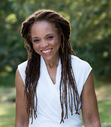Sophfronia Scott's Blog: Sophfronia Scott, Author, page 25
June 9, 2018
Deviate Podcast Features Sophfronia Scott
In this episode of Deviate, Rolf Potts speaks with Sophfronia Scott about her working-class Ohio upbringing, and the background behind her name (2:40); her beginnings at TIME Magazine and her groundbreaking article on Generation X (13:00); her mid-life career change and commitment to a career as an author (30:00); her spiritual journey (40:00); and dealing with her son’s experience as a student at Sandy Hook Elementary (49:00).
The entire podcast can be heard at this link.
Love’s Long Line Listed by The Root
The Root published a list of new and upcoming books by black authors that “will give you life in these perilous times.”
“Novelist, journalist and professor Sophfronia Scott offers Love’s Long Line, a collection of essays pondering questions of race, motherhood and cultural events.”
Unforgivable Love Featured in Bookface Photo Series
The Amesbury Public Library in Amesbury, Massachusetts recently created and featured in its social media a “bookface” illustration of Unforgivable Love. A bookface image uses a live model to bring the cover image of a book to life. The Unforgivable Love image has been praised and shared multiple times.
Assay Journal Interview with Sophfronia Scott
Assay: A Journal in Nonfiction Studies, recently featured an interview with Sophfronia Scott in which she and the writer Elizabeth Cohen discuss Love’s Long Line and This Child of Faith.
“In the amphitheater of American horror stories, the 2012 Sandy Hook school shooting of 20 school children and six adult staffers may be the saddest of all. The writer Sophfronia Scott, in her two new creative nonfiction books, This Child of Faith and Love’s Long Line, explores various facets of the tragedy and other topics with the vise of witness and her writer’s deep and empathic eye. Her son Tain attended the school and he survived that day. Not so his dear friend Ben, and many others from their community. Her two books, one written as a co-author with Tain, now 13, parse the enormity of that loss, along with the largest subjects of them all: faith, origins, life’s fragility, and motherhood with a capital M.”
June 7, 2018
The Nature of Everyday Hope
June is here and once again I feel perched on the edge of something. School will be out in a few weeks for both my son and my teacher husband. When I think of the long sunny days before us I see possibility and the wonder of how we might enjoy those days. I think about hikes and drives and catching the moments when we can do absolutely nothing. I hope this time might be as bountiful as the thick foliage of the trees in our neighborhood, as colorful as the coneflower that will soon bloom in our yard, as surprising as the sight of hummingbirds that appear occasionally to feed on the petunias in the planters on my deck.
But this is a cautious, sometimes fragile, hope. I recall another June, seven years ago, when I’d bought my son his first pair of hiking boots and planned on exploring all the child-friendly hikes I could find in our state. Then suddenly, within a few days of each other, both a beloved friend and one of my sisters died. I’ve written about this event in my books Love’s Long Line and This Child of Faith so I won’t go into details of the past. I’m writing today in terms of how that past affects my life now.
Sometimes when I recognize that I’m anticipating summer and feeling hopeful and happy I sense a hesitation in my being, like I’m watching my back or waiting for some devastating other shoe to drop. Suddenly I don’t trust the goodness I’m feeling. More than once I’ve had tragedy follow a strong feeling of positivity. The morning of 9/11, before walking to work, I’d sat on a stoop and marveled over the brilliance of the blue sky and a gentle moon above my head. I remember specifically feeling that I felt safe and life was good. Years later, the day before the Sandy Hook shootings, I even wrote that phrase “life is good” in my social media as I sat in our church’s library listening to my son and the children’s choir rehearse Christmas carols.
I’m continually having to release this suspicion and re-learn trust. Actually, I’m not sure if this trust is something one can learn or if I just have to do it, like jumping from a diving board. I do know I need it. Otherwise I would always be on edge, unable to move forward, unable to plan, unable to hope. If I’ve learned anything it’s that life moves forward regardless. It’s up to me to figure out how I will handle it and walk in God’s love as it does. I explored some of this in my recent column for Ruminate, “The Shape of Grief,” which you can read at this link. I wrote about the loss of my dear friend, the noted audiobook narrator Katherine Kellgren, and how I’m trying to understand this back and forth between grief and enjoying everyday life, seeking a balance of being able to endure the slings and arrows of this outrageous world while still believing in life and love.
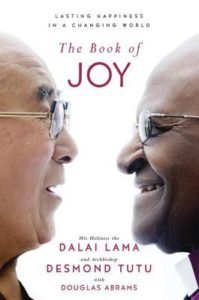 Acknowledging I have these feelings is important, though. I can sense that. These thoughts led me to read The Book of Joy: Lasting Happiness in a Changing World by the Dalai Lama and the South African Archbishop Desmond Tutu. The two spiritual leaders, close and loving friends, affirmed my feelings are indeed among the obstacles to joy. But I don’t have to let them spoil my experience of life.
Acknowledging I have these feelings is important, though. I can sense that. These thoughts led me to read The Book of Joy: Lasting Happiness in a Changing World by the Dalai Lama and the South African Archbishop Desmond Tutu. The two spiritual leaders, close and loving friends, affirmed my feelings are indeed among the obstacles to joy. But I don’t have to let them spoil my experience of life.
“Sadly, many of the things that undermine our joy and happiness we create ourselves,” said the Dalai Lama in the book. “Often it comes from the negative tendencies of the mind, emotional reactivity, or from our inability to appreciate and utilize the resources that exist within us.”
How does one do that, appreciate and utilize? They offer up many practices to work with and at the heart of them all is this particular thought, which hits home for me: “What the Dalai Lama and I are offering,” said Archbishop Tutu, “is a way of handling your worries: Thinking about others.”
My way of doing this is writing. I know I’m not the only one who might feel a tug in the stomach when a crystal blue sky recalls the morning of 9/11, or when noticing the ordinary hubbub at the start of day was the same as that of 12/14. So I share this with others, with you. I open the door—and my heart—to whatever might come next. And then I move on, with hope. As Archbishop Tutu says, “To choose hope is to step firmly into the howling wind, baring one’s chest to the elements, knowing that, in time, the storm will pass.”
May 18, 2018
The Best Laid Plans
Gang aft agley…”
–Robert Burns, “To a Mouse”
Oh yes…that planning thing. Sometimes it works, sometimes it doesn’t, sometimes both in the same day. Tuesday proved to be just such a day.
I woke and went downstairs to check the weather reports for New York City, my destination for the afternoon to attend a memorial service. The meteorologist forecast heavy rains for precisely the time the service would be ending. When it rains in Manhattan it can be nearly impossible to hail a cab, especially during rush hour. I thought of a friend’s mother and how she would probably need a ride home after the service. If I drove my minivan into the city early and found a parking space near the church, I could be that ride for her.
And it worked out just like that. There were a few bumps: I couldn’t park as closely as I would have liked because New York University’s commencement ceremonies took place that day. But I did get a spot and I did give my friend and her mother rides home in the pouring rain.
 This also happened: Right when the service ended and I was on my way out to retrieve my minivan, I received a call from my husband. He said what seemed to be a tornado had struck our Connecticut neighborhood. Within minutes trees had fallen all over town. Our house, along with homes in the majority of our town, had no power. Okay.
This also happened: Right when the service ended and I was on my way out to retrieve my minivan, I received a call from my husband. He said what seemed to be a tornado had struck our Connecticut neighborhood. Within minutes trees had fallen all over town. Our house, along with homes in the majority of our town, had no power. Okay.
I made my way home that night through the wreckage. This was some storm. The trees weren’t just knocked down, they were SHREDDED. It’s like Mother Nature wanted to make potholders by weaving together branches and power lines. It will take time and care to untangle the mess.

Photo by Donald Wismann
What had been my plans for the rest of the week? They had included writing for my next novel, a luncheon with college classmates, reading time, more writing. Most of that has been out the window. Schools for both my son and husband (he’s a middle school band director) are closed.
I could be tense and frustrated. Instead I’m focusing on what I can and have been able to do. My friend, the writer Peter Wright, is visiting from Florida so my family and I spent time with him on a rainy Wednesday. We hunkered down Thursday in our church’s library where I began writing this and our son hung out with one of his friends from school while our devices charged.
Today a nearly thwarted plan succeeded—my husband was able to salvage a scheduled performance field trip with his students at an amusement park and our son joined him. I’m again in the church library writing. Tomorrow I’ll go back into the city and participate in a friend’s memorial service for her husband. We might have power by Sunday.
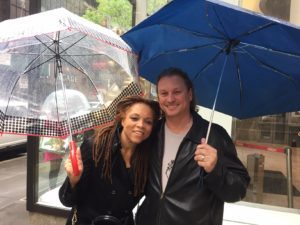
With Pete Wright in NYC. Photo by Darryl Gregory
I’m appreciating the calm of this room and the sound of my friend Don, the music minister here, practicing the organ in the sanctuary. I have my calendar/planner open on the table in front of me and I’m working on checking off a few items on my to-do list before I can bring myself to turn the page and think about plans for next week. But this is life. I’ll take it as it comes, planning as I’m able but holding those plans loosely, knowing some may work out and some may not. It’s all good.
February 23, 2018
About Faith: What I Want You to Know
Sometimes an interview question hits home. When it does the question becomes much more than a question. It’s a request for depth, for clarity, for the utmost authenticity. It wants to know what’s inside you that you can offer up with the most light possible. It’s asking what you want the world to see.
I heard such a question recently when I was interviewed by Megan Dewald for a series by the Princeton Theological Seminary called The Thread. We talked about vocation, writing, and hope. Then, in the last few minutes of the brief session, Megan asked me the question that resonated to the core of my being: What have I learned in my life about faith, and what do I want Christians to know about it? I hope I responded not just for Christians, but for everyone. You can have a listen and hear my answer by going to this link. Let me know if it hits home for you.
Be well.
February 13, 2018
A Diet for the Soul
Can you pity a bad/mean/evil character? This question came up in a book group discussion of my novel Unforgivable Love. I responded by quoting Albus Dumbledore in the second Harry Potter and the Deathly Hallows film, where he tells Harry to pity the living and most of all pity those who live without love. A friend in the group commented she loves how I can pull these pertinent references right out of the air.
I appreciate the compliment but let me clarify something: I didn’t pull it out of the air. I pulled it out of me. These words are inside of me because when I first read them in J.K. Rowling’s novel they struck me as so right and so beautiful that I’ve consumed them again and again, both on the page and onscreen.
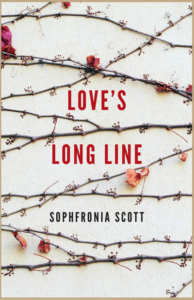 What’s the point of watching a film or reading a poem/book/Bible verse again and again? At first I thought this was just a weird habit that I have, one that dates back to childhood. But now, as a writer, I realize that just as food nourishes my body, art feeds my creative soul. Sometimes it feels like the art provides answers. Sometimes it feels like a puzzle piece, and over time I’m looking to make connections, to see where this lovely thing fits in with the way the world is unfolding before me. These ruminations form the heart of my new book, an essay collection called Love’s Long Line.
What’s the point of watching a film or reading a poem/book/Bible verse again and again? At first I thought this was just a weird habit that I have, one that dates back to childhood. But now, as a writer, I realize that just as food nourishes my body, art feeds my creative soul. Sometimes it feels like the art provides answers. Sometimes it feels like a puzzle piece, and over time I’m looking to make connections, to see where this lovely thing fits in with the way the world is unfolding before me. These ruminations form the heart of my new book, an essay collection called Love’s Long Line.
Today I caught the end of Genius, the film in which Colin Firth plays the legendary editor Maxwell Perkins and Jude Law is Thomas Wolfe. In the last scene Max is reading a letter from Tom, a letter written on his deathbed. The scene struck my heart and I knew I’d want to hear the words Max reads again and again:
I’ve made a long voyage and been to a strange country. And I’ve seen the dark man very close and I don’t think I was too much afraid of him.
What I want most desperately is to live. I want to see you again…
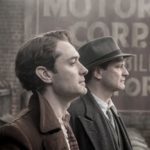 …I shall always feel about you the way I did that November day when you met me at the boat and we went on top of the building and all the strangeness and the glory and the power of life were below. Yours always, Tom
…I shall always feel about you the way I did that November day when you met me at the boat and we went on top of the building and all the strangeness and the glory and the power of life were below. Yours always, Tom
Max removes his hat. Tears flow down his cheeks.
This wasn’t the first time I’d seen the film but for the first time I added my own tears. I picked up the remote and watched the scene four more times. I’m in tears now as I type this. I’m thinking about the strangeness and the glory and the power of life. I’m thinking about my friend Katy who died last month. She too wanted to live. I sense how these thoughts and the words from the scene are becoming stitched into my being and I allow it. I don’t know if I will write something beyond this, but I do know these words and this feeling will all come out the next time I’m in a conversation about life and love and death.
There are many such moments in this film. Here’s a clip of Perkins reading Wolfe’s own words back to him. They are the most exquisite words.
I find comfort in the beauty of these words. I consume them as I do Scripture, poetry, films, and music. I take it all in and it comes through me, in conversation and in prayer, when I need it the most.
So my question to you: What are you taking in? Are you consuming anything that takes your breath away, that makes you want something better for yourself, that makes you see light in the world? If you can’t answer, think about what you express—what do you say in conversation, what are the thoughts that are topmost in your mind?
If you don’t find enough light and wonder in your diet I challenge you to change it. And you don’t necessarily have to go seeking something new. Sometimes wonder is right in front of you. Are you willing to notice it? Are you willing to let it move you, to change you?
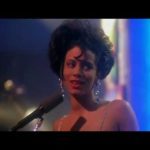 When I talk about this with students I show them this clip of the song “Harlem Blues” from Spike Lee’s film ‘Mo Better Blues. I explain how I haven’t seen the film in years but I’ve listened to this song hundreds of times. I’m sure it is the undercurrent that led me to write Unforgivable Love. When I listen to the song I think about Harlem, yes, but I also think about the story from the film. The character singing is named Clarke (played by Cynda Williams) and throughout the film she wants to sing with Bleek’s jazz ensemble but Bleek, played by Denzel Washington won’t let her. He’s even told, “You should hear Clarke sing,” but he’s too wrapped up in his own music to listen or really care.
When I talk about this with students I show them this clip of the song “Harlem Blues” from Spike Lee’s film ‘Mo Better Blues. I explain how I haven’t seen the film in years but I’ve listened to this song hundreds of times. I’m sure it is the undercurrent that led me to write Unforgivable Love. When I listen to the song I think about Harlem, yes, but I also think about the story from the film. The character singing is named Clarke (played by Cynda Williams) and throughout the film she wants to sing with Bleek’s jazz ensemble but Bleek, played by Denzel Washington won’t let her. He’s even told, “You should hear Clarke sing,” but he’s too wrapped up in his own music to listen or really care.
At the end of the film, here is Clarke singing. And it’s a magnificent thing. You see Bleek stunned. You see Clarke in her glory. I’m inspired to think about my own gift, the equivalent of my own singing. Am I singing?
Here’s the video. I hope it inspires you to think about what you’re bringing into yourself, and whether it’s making you sing.
February 8, 2018
Slide: Unforgivable Love
AVAILABLE NOW WHEREVER BOOKS ARE SOLD
#fusion-testimonials-1 a{border-color:#ffffff;}#fusion-testimonials-1 a:hover, #fusion-testimonials-1 .activeSlide{background-color: #ffffff;}.fusion-testimonials.clean.fusion-testimonials-1 .author:after{border-top-color:rgba(255,255,255,0) !important;}
Erika Robuck, bestselling author of Hemingway's Girl
“Complicated characters, unbearable tension, heartbreak,
and betrayal make Unforgivable Love an absorbing read.”
Tayari Jones, author of Silver Sparrow and An American Marriage
“Unforgivable Love is lyrical and lush, enchanting and energetic. With botttomless empathy and loving attention to detail, Sophfronia Scott embraces a classic and makes it her own.”
Karen E. Bender, author of Refund, Finalist for the National Book Award
“Scott’s wonderful, original retelling of Dangerous Liaisons takes readers deep into the lives of her characters; Mae, Val, and Elizabeth are riveting and complex. You won’t be able to stop reading this terrific, absorbing book.”
Bret Lott, New York Times bestselling author of Jewel
“At once beautiful and ominous, visceral and ethereal, tragic and fulfilling, Unforgivable Love is a genuinely moving novel […] Sophfronia Scott has given us a book that will last, an elegant page turner that transcends time and place.”
Christine Sneed, author of The Virginity of Famous Men and Little Known Facts
“Unforgivable Love is an exquisite, sexy, beautifully imagined novel in which Sophfronia Scott expertly recasts the intrigues and characters of Dangerous Liaisons in Harlem of the late 1940s. Both a virtuosic homage and a thrilling retelling–Unforgivable Love is a stunning accomplishment.”
Robin Black, author of Life Drawing
“Unforgivable Love is an unforgettable read. Scott’s reimagining of Dangerous Liaisons into 1940’s Harlem society is nothing short of inspired, with all the spice and spite and delight of the original, and more. Nuanced, haunting, elegant, this is a book I can’t wait to read again – and then, again.”
Richard Bausch, award-winning author of Before, During, After
“ […] here is this eighteenth century French tale remade into a panorama of mid-century Harlem, America–full of brilliant characters, a tale of love and lust and treachery, written with the rhythms of jazz, giving forth beautifully rendered rooms and streets and sounds […] better than the original.”
Lee Martin, Pulitzer Prize Finalist author of The Bright Forever
“Unforgivable Love is a fast-paced tale of intrigue, seduction, and betrayal. Sophfronia Scott leaves us breathless.”
Breena Clarke, author of the award-winning Oprah book club pick, River, Cross My Heart
“Scott’s novel is a vivid, vibrant, and panoramic exploration of the hearts and minds of its mostly well-heeled characters and the universal themes of love, sex, and social intrigue […]Scott takes readers there and lets them wander and discover this exciting, historical time and place.”
Lori Ostlund, author of After the Parade
“Imagine Dangerous Liaisons set in 1940s Harlem, amidst the nascent civil rights movement, baseball, and jazz, and you have Sophfronia Scott’s riveting novel Unforgivable Love.[…] I miss this world-and Scott’s gorgeous prose already.”
Martha Southgate, author of The Fall of Rome
“Unforgivable Love is vibrant, thoughtful and very sexy. It sneaks up on you and once you are under its spell, it won’t let go.”
Bill Roorbach, award-winning author of Life Among Giants and The Girl of the Lake
“Why do the worst people always seem to win? In this remarkable retelling of the French classic Les Liasions Dangereuses, Sophfronia Scott brings scandal, manipulation, and perverse desire to (barely) postwar America. Never have I rooted against a protagonist so fervently, all the while taking secret pleasure in the subversion of virtue. But wait. Who really wins here? Beautifully written, sumptuously atmospheric, fearless in its cultural appropriation, UNFORGIVABLE LOVE is surely the breakout book for this thrilling new voice.”
.fusion-button.button-1 .fusion-button-text, .fusion-button.button-1 i {color:#ffffff;}.fusion-button.button-1 {border-width:0px;border-color:#ffffff;}.fusion-button.button-1 .fusion-button-icon-divider{border-color:#ffffff;}.fusion-button.button-1:hover .fusion-button-text, .fusion-button.button-1:hover i,.fusion-button.button-1:focus .fusion-button-text, .fusion-button.button-1:focus i,.fusion-button.button-1:active .fusion-button-text, .fusion-button.button-1:active{color:#ffffff;}.fusion-button.button-1:hover, .fusion-button.button-1:focus, .fusion-button.button-1:active{border-width:0px;border-color:#ffffff;}.fusion-button.button-1:hover .fusion-button-icon-divider, .fusion-button.button-1:hover .fusion-button-icon-divider, .fusion-button.button-1:active .fusion-button-icon-divider{border-color:#ffffff;}.fusion-button.button-1{width:auto;}Learn More.fusion-button.button-2 .fusion-button-text, .fusion-button.button-2 i {color:#ffffff;}.fusion-button.button-2 {border-width:0px;border-color:#ffffff;}.fusion-button.button-2 .fusion-button-icon-divider{border-color:#ffffff;}.fusion-button.button-2:hover .fusion-button-text, .fusion-button.button-2:hover i,.fusion-button.button-2:focus .fusion-button-text, .fusion-button.button-2:focus i,.fusion-button.button-2:active .fusion-button-text, .fusion-button.button-2:active{color:#ffffff;}.fusion-button.button-2:hover, .fusion-button.button-2:focus, .fusion-button.button-2:active{border-width:0px;border-color:#ffffff;}.fusion-button.button-2:hover .fusion-button-icon-divider, .fusion-button.button-2:hover .fusion-button-icon-divider, .fusion-button.button-2:active .fusion-button-icon-divider{border-color:#ffffff;}.fusion-button.button-2{width:auto;}Buy Now

December 31, 2017
My Favorite Books of 2017
I’m grateful for Goodreads. Before this lovely book-oriented social media site came into the world my reading life was pretty scattered. Sometimes I tried to keep written books lists but most of the time I really didn’t know how much or how little I’d read in any given year. When I entered graduate school (six years ago this month) to earn my MFA in creative writing, I felt it essential to pay closer attention to what I’ve read and what I want to read. Goodreads has and continues to help me do that. I especially love the annual reading challenge. I tend to keep my goal for the challenge at 40 books a year–enough of a stretch that it’s not easy, but attainable. Many of the books I’ve encountered this year have left their marks on me both as a reader and as a writer. In fact, I emerge from 2017 feeling a little like I’ve been visited by spirits representing literature’s past, present, and future. Check out my favorite reads of the year, including what I wrote when I reviewed them, and you’ll see what I mean. I hope your 2018 will be filled with plenty of challenging, inspiring, life-affirming works like these.
The Past
Max Perkins: Editor of Genius by A. Scott Berg
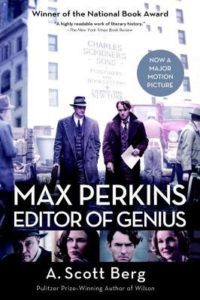 Recently while scrolling through the movie channels on cable I discovered the film “Genius” starring Colin Firth as the editor Max Perkins and Jude Law as Thomas Wolfe. The image of Law waiting on the pavement, shifting on his feet while Firth read through a manuscript hooked me. I found the whole film intriguing. When I saw in the credits that the film was adapted from a biography of Perkins, Max Perkins: Editor of Genius, written in the 1970s. I found the book and became engrossed. There are parts of the book when it seems like the publishing world of the early 20th century was a lot simpler back then, but then there are times when Perkins and his writers are dealing with exactly the same issues we deal with today concerning money, sales, publicity, and finding time to write. Once the Depression took hold Scribner’s and Sons (where Perkins famously worked) only made a third of what the publishing house had taken in the previous year. And yet Perkins, the other editors, and their writers hung in there. Perkins was constantly encouraging his writers to write.
Recently while scrolling through the movie channels on cable I discovered the film “Genius” starring Colin Firth as the editor Max Perkins and Jude Law as Thomas Wolfe. The image of Law waiting on the pavement, shifting on his feet while Firth read through a manuscript hooked me. I found the whole film intriguing. When I saw in the credits that the film was adapted from a biography of Perkins, Max Perkins: Editor of Genius, written in the 1970s. I found the book and became engrossed. There are parts of the book when it seems like the publishing world of the early 20th century was a lot simpler back then, but then there are times when Perkins and his writers are dealing with exactly the same issues we deal with today concerning money, sales, publicity, and finding time to write. Once the Depression took hold Scribner’s and Sons (where Perkins famously worked) only made a third of what the publishing house had taken in the previous year. And yet Perkins, the other editors, and their writers hung in there. Perkins was constantly encouraging his writers to write.
I like how in the book Hemingway, Fitzgerald, and Wolfe are flesh and blood humans, not the cardboard literary icons that sit on bookshelves today. I have compassion for them all, especially Fitzgerald, who lived way beyond his means and couldn’t focus on his next novel because he was too busy writing short stories for the Saturday Evening Post because they paid him so well. And this despite Perkins constantly sending him advances. But I also admire the way Perkins and his writers spoke of “the work,” how committed they were to it despite what else was going on.
The Present
Hunger: A Memoir of (My) Body by Roxane Gay
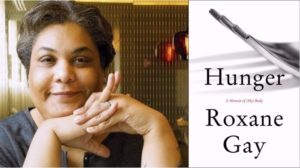 “I don’t know how I let things get so out of control, but I do.” These words, repeated a few times in Roxane Gay’s memoir, hold the tension of this important work. The tension is the push and pull between strength and vulnerability, courage and fear, reality and illusion, knowledge and confusion. This tension is where the author lives. “…here is my heart, what’s left of it. Here I am showing you the ferocity of my hunger.”
“I don’t know how I let things get so out of control, but I do.” These words, repeated a few times in Roxane Gay’s memoir, hold the tension of this important work. The tension is the push and pull between strength and vulnerability, courage and fear, reality and illusion, knowledge and confusion. This tension is where the author lives. “…here is my heart, what’s left of it. Here I am showing you the ferocity of my hunger.”
I admire this stance. I like how Gay, in a world that adores happy endings and experiences neatly dissected for meaning, “went there,” showing the pain and frustrations she continues to endure. She isn’t afraid to admit the story is ongoing. But hope is present in her life, in tiny glowing balls that remind her she is not totally in darkness: she is loved, her work is affecting lives, she is seeking the geographic place her heart most wants to call “home.” For this reason, the fact of its clear-eyed and difficult truthfulness, I believe this book will do more for more people than a truckload of all those happy ending books could ever do. Gay says this was a hard book to write. I am glad she managed to do it.
The Future
Lincoln in the Bardo by George Saunders
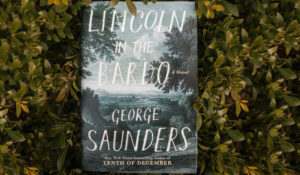 For me this book represented a brave new world of storytelling. Any writer can break the rules of our craft. If he does it poorly the resulting pieces remain at our feet and the confused reader is left to kick at them unsatisfied, like viewing the aftermath of an accident. But if the writer succeeds, he breaks rules to the point where he actually plants the resulting debris and a new form grows. The reader takes in the nascent creation with either bewilderment and possible dislike or sheer wonder. From the comments I’ve consumed about Lincoln in the Bardo, readers report from both viewpoints. Here’s my take. I started on the bewilderment side and ended this book in wonder.
For me this book represented a brave new world of storytelling. Any writer can break the rules of our craft. If he does it poorly the resulting pieces remain at our feet and the confused reader is left to kick at them unsatisfied, like viewing the aftermath of an accident. But if the writer succeeds, he breaks rules to the point where he actually plants the resulting debris and a new form grows. The reader takes in the nascent creation with either bewilderment and possible dislike or sheer wonder. From the comments I’ve consumed about Lincoln in the Bardo, readers report from both viewpoints. Here’s my take. I started on the bewilderment side and ended this book in wonder.
George Saunders’s debut novel is set in a time of upheaval, the early days of the Civil War, when the country was only beginning to realize the horrible depths it was careening toward. President Lincoln’s young son Willie, age eleven, takes ill and dies. His body is placed in a crypt in a cemetery populated by a whole community of less than restful souls. But one night Lincoln, burdened by worry and grief, feels impelled to return to the tomb to visit his lost child. What he leaves with and how he does so is a striking fulfillment of this tale.
Here’s where the rule-breaking comes in: The story is told at a distance, through the observations of the dead souls and through historical source material Saunders uses abundantly though I couldn’t tell which of these many footnotes were based on real material and what was imagined. Fiction craft lessons often teach writers to create characters who are active, not passive, and who can bring urgency to the narrative while at the same time inciting emotion, positive or negative, from the reader. When I began reading Lincoln in the Bardo, I was skeptical. I didn’t see how Saunders could conjure urgency, action, or emotion when the main character, President Lincoln, is for the most part a quiet, introspective, grieving presence and everyone else, a host of strangers without historical significance, was dead.
My curiosity kept me reading and I’m glad I did because Saunders succeeds in all this and that is the miracle of the book. I won’t say how he creates urgency, but I will speak a little on the emotional aspect.
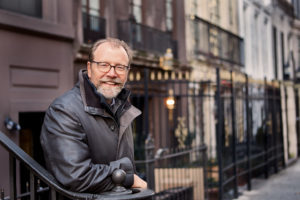
Photo from pw.org
At first I wasn’t interested in these ancillary characters. They spend a lot of time talking, stating their cases, and telling their own death stories. They rarely listen other than to appraise another person’s situation and compare whether they are better or worse off than the other. I kept wanting to get back to Lincoln: Where is he? What’s he doing? But there came a pivotal scene, which I won’t reveal here, where that situation changes and I realized or recognized something I can only describe using the lyrics from John Lennon’s “I Am the Walrus”: “I am he as you are he as you are me/ And we are all together…”
They are us. These characters represent all of us.
The scene provides a kind of light for the lost souls and one character, Mr. Vollman, observes, “My God, what a thing! To find oneself thus expanded!” These souls are essentially seeking, as we who are living are also seeking, a sense of connection—a certain wholeness. How they come to it is one of the most touching parts of the narrative. Their realization opens the world for them and, for me, turned the book into a profound statement of empathy, compassion, and what it means to be human. As a reader I felt moved; as a writer I felt delight over what the author had accomplished. I wanted to read the book again, immediately, so I could better understand and appreciate how Saunders, with such expert craftsmanship and many twists and turns, had built the book.
Writers read for enjoyment, yes, but we also read to learn what art is possible to craft from our tools, which range from basic words and sentences to scintillating, airborne imagination. With Lincoln in the Bardo, an impressive demonstration of skill and imagination, Saunders, simply put, shows a new way of presenting a story. I hope he inspires many writers to let loose in mind and spirit, and see what we can share in our own ongoing quests, acknowledged or not, for wholeness.

